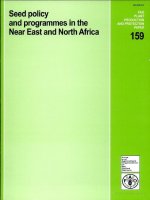The Monocots Basal and “Petaloid” Groups
Bạn đang xem bản rút gọn của tài liệu. Xem và tải ngay bản đầy đủ của tài liệu tại đây (107.83 KB, 29 trang )
The Monocots
Basal and “Petaloid” Groups
Synapomorphies of Monocots
• Root system adventitious
• One cotyledon
• Stems with scattered vascular bundles (no
•
•
•
•
secondary growth); herbaceous
Leaves parallel-veined with a sheathing
base
Flowers pentacyclic (5 whorls), trimerous
Sieve cell plastids with several cuneate
protein crystals
Lots of molecular support for monophyly
Additional features of monocots
• Leaves formed from the basal end of the
leaf primordium
• Usually with monosulcate pollen
• Lack glandular teeth on leaves
Basal and “Petaloid” Monocot Groups
Order Acorales
Acoraceae
Order Alismatales
Araceae
Alismataceae
Order Liliales
Liliaceae
Order Asparagales
Agavaceae
Alliaceae
Amaryllidacaee
Iridaceae
Orchidaceae
Basal Monocots:
Acorales: Acoraceae
not required
• Widespread, temperate throughout tropical
regions
• Aquatic herb
• Diversity: 1-3 spp. in 1 genus (Acorus)
• Flowers: typical of Araceae, coalesced into a
spike-like spadix
• Significant features: Sister to the rest of the
monocots; contain ethereal oils.
• Special uses: none
• Family not required, but Acorus
evolutionarily important
“Petaloid” Monocots—Alismatales:
Araceae
(The Arum Family)
•
•
•
•
•
•
•
Cosmopolitan; greatest diversity in tropical regions
Terrestrial and aquatic herbs, vines, epiphytes,
floating aquatics
Diversity: 3,300 species, 109 genera
Flowers: many, small; lacking extensive perianth,
carpels 2-3; if unisexual then spatially separated in
inflorescence or sometimes plants dioecious
Significant features: inflorescence – spadix subtended
by a spathe (specialized leaf)
Special uses: many ornamentals; Colocasia as food
Required taxa: Arisaema, Lemna
•
•
•
•
-spathe margins overlapping below, spathe mostly arched
above,
striped or marked
-spadix usually slender and elongate
-flowers unisexual and only at the base of the spadix
Araceae: Lemna and friends
•Reduced plant body: no stem or leaves;
sometimes no roots
•Rarely flower
“Petaloid” Monocots—Alismatales:
Alismataceae : not required
(The Water Plantain Family)
• Widely distributed
• Aquatic & wetland rhizomatous herbs
• Number of species: 88 species, 15 genera
• Flowers: sepals & petals distinct, many
•
•
•
apocarpous carpels; flowers or floral axes
often whorled
Significant features: rhizomatous
Special uses: ornamental aquatics
Family not required
Liliales
• Nectaries at base of tepals
• Spots on tepals
• Extrorse anthers
“Petaloid” Monocots—Liliales:
Liliaceae
(The Lily Family)
• Widely distributed in temperate regions of the
Northern Hemisphere
• Perennial herbs, usually with bulbs and
contractile roots
• Number of species: ca. 600 species, in 16
genera
• Flowers: tepals 6, distinct, carpels 3, stamens 6
• Significant features: Fruit a loculicidal capsule,
sometimes a berry; no onion-like odor
• Special uses: many ornamentals
• Required taxa: Erythronium, Tulipa
ASPARAGALES
Asparagales
• Herbs to woody;
sometimes succulent
•Tepals not spotted
•Nectaries septal
•Style usually 1, simple
•Seed coat collapsed
to + present
•Phytomelan crust
(seeds black) from dry
fruits; not in fleshy fruit
vs.
Liliales
• Herbs; not succulent
•Tepals often spotted
•Nectaries at base
of tepals/filaments
•Styles 1 (trifid) or 3
•Seed coat present
•No phytomelan crust
(seeds not black)
“Petaloid” Monocots—Asparagales:
Alliaceae
•
•
•
•
•
•
•
(Onion Family)
Widely distributed in temperate and tropical regions;
also semiarid.
Bulb-forming herbs with basal, usually narrow leaves
Number of species: ca. 600 species, in 13 genera
Flowers: Often showy, tepals 6, stamens 6, 3 connate
carpels, ovary superior; inflorescence umbellate; fruit
a loculicidal capsule.
Significant features: sulfur-containing compounds
(onion odor)
Special uses: onion, garlic, leek, shallots, chives, used
as food & seasonings; ornamentals
Required taxa: Allium
“Petaloid” Monocots—Asparagales:
Amaryllidaceae
(Amaryllis or Daffodil Family)
•
•
•
•
•
•
•
Widely distributed in temperate to tropical regions;
maximal diversity in South Africa, Andean South
America, and the Mediterranean
Bulb-forming herbs with contractile roots
Number of species: 850 species in 59 genera
Flowers: often showy; tepals 6; stamens 6,
sometimes adnate to perianth; carpels 3, inferior
ovary; fruit usually a loculicidal capsule
Significant features: special alkaloid compounds
present
Special uses: many ornamentals ( Narcissus,
Hippeastrum)
Family not required
“Petaloid” Monocots—Asparagales:
Iridaceae
•
•
•
•
•
•
•
(The Iris Family)
Widespread in tropical and subtropical regions;
absent in Australia.
Perennial herbs forming rhizomes, corms, or bulbs
Number of species: ca. 1,750 species, 67 genera
Flowers: radial or bilateral, showy; tepals 6, outer
tepals often differentiated from inner; stamens (2) 3,
opposite outer tepals; carpels 3, fused into an
inferior ovary; fruit a loculicidal capsule
Significant features: leaves unifacial or terete,
equitant
Special uses: many ornamentals; saffron ( Crocus
sativus)
Required taxa: Iris
“Petaloid” Monocots—Asparagales:
Orchidaceae
•
•
•
•
•
•
•
(The Orchid Family)
Widespread throughout the world; maximal diversity in
tropical regions
Primarily epiphytes; some terrestrial herbs, occasionally
vines
Diversity: ca. 20,000 species in 700-800 genera
Flowers: showy, usually resupinate, bilateral, the median
inner tepal differentiated into a labellum (lip); highly modified
androecial and gynoecial parts, fused into a column; pollen
grouped into soft or hard masses (pollinia) united by a stalk
into a pollinarium; ovary inferior; placentation parietal; fruit a
capsule dehiscing with (1-)3 or 6 slits; seeds tiny, dust-like
Significant features: among the most specialized of all
angiosperm flowers
Special uses: many ornamentals; Vanilla
Required taxa: family only
The Monocots
Commelinid Monocots
Commelinid characters
•
•
•
Special type of epicuticular wax
Starchy pollen
UV-fluorescent compounds in the cell
walls
• Starchy endosperm (except in the palms)
• Lots of molecular support
Commelinoid Monocot Groups
Order Arecales – Palms
Arecaceae (Palmae)
Order Commelinales – Spiderworts,
bloodworts, pickerel weeds
Order Zingiberales – Ginger, banana, and
allies
Order Poales – Bromeliads, Cat-tails,
Rushes, Sedges, and Grasses
Typhaceae
Juncaceae
Cyperaceae
Poaceae (Gramineae)
Commelinoid Monocots:
Arecales: Arecaeae (Palmae)
•
•
•
•
•
•
•
Widespread throughout tropical and warm temperate
regions
“Trees” or “shrubs”, typically unbranched
Diversity: ca. 2,000 in 190 genera
Flowers: usually sessile, in compound-spicate
inflorescences, these subtended by a bract (spathe);
ovule 1 per locule
Significant features: Leaves alternate or spiral, blades
plicate, splitting in a pinnate or palmate manner
Special uses: coconut (Cocos nucifera), date
(Phoenix dactylifera), rattan (Calamus), oils and
waxes, ornamentals
Family not required
Arecaceae
•Numerous small flowers
•Spathes + compound-spicate inflorescence
•3 sepals + 3 petals
•Superior ovary (carpel fusion varies)
•Drupe
•Unbranched trunks
•Big leaves on top!
Commelinid Monocots:
Zingiberales
•
•
•
•
•
•
•
•
•
•
•
Large herbs with vessels more or less limited to the roots
Silica cells present in the bundle sheaths
Leaves clearly differentiated into a petiole and blade
Leaf blade with penni-parallel venation, often tearing between
the second-order veins
Leaf blade rolled into a tube in bud
Petiole with enlarged air canals
Flowers bilateral (or irregular)
Pollen lacking an exine
Ovary inferior
Seeds arillate and with perisperm (diploid nutritive tissue derived
from the nucellus)
8 families and nearly 2000 species
Characters of Poales
• Silica bodies (in silica cells) in the
epidermis
• Styles strongly branched
• Loss of raphide (needle-like) crystals in
most
• Much molecular support for monophyly
• Wind pollination has evolved several times
independently within the order
• Ecologically very important
Commelinid Monocots—Poales:
Bromeliaceae
(The Pineapple/Bromeliad Family)
• Tropical to temperate regions of the Americas
• Predominantly epiphytic herbs (“tank” plants)
• Diversity: ca. 2,400 species in 59 genera
• Flowers: radial, perianth differentiated into
•
•
•
calyx and corolla, borne in axils of often
brightly colored bracts; inflorescences spicate
or paniculate; stigmas 3, usually twisted;
seeds often winged or with tufts of hair
Significant features: leaves with water
absorbing peltate (or stellate) scales
Special uses: pineapple (Ananas)
Family not required
Commelinid Monocots—Poales:
Cyperaceae
(The Sedge Family)
•
•
•
•
•
•
•
Worldwide, usually in damp or semi-aquatic sites
Rhizomatous herbs, stems usually triangular in
cross section and solid
Diversity: 5,000 species in 104 genera
Flowers: with 1 subtending bract; tepals absent or
reduced to 3-6 scales or hairs; stamens 1-3; carpels
2-3 in superior ovary; fruit an achene (nutlet)
Significant features: Inflorescence a complex
group of spikelets; leaf sheaths closed, ligule
lacking; silica bodies conical
Special uses: Papyrus used originally for paper;
“water chestnuts” and a few other rhizomes edible,
leaves used for weaving; some ornamentals.
Required taxa: Carex, Cyperus









